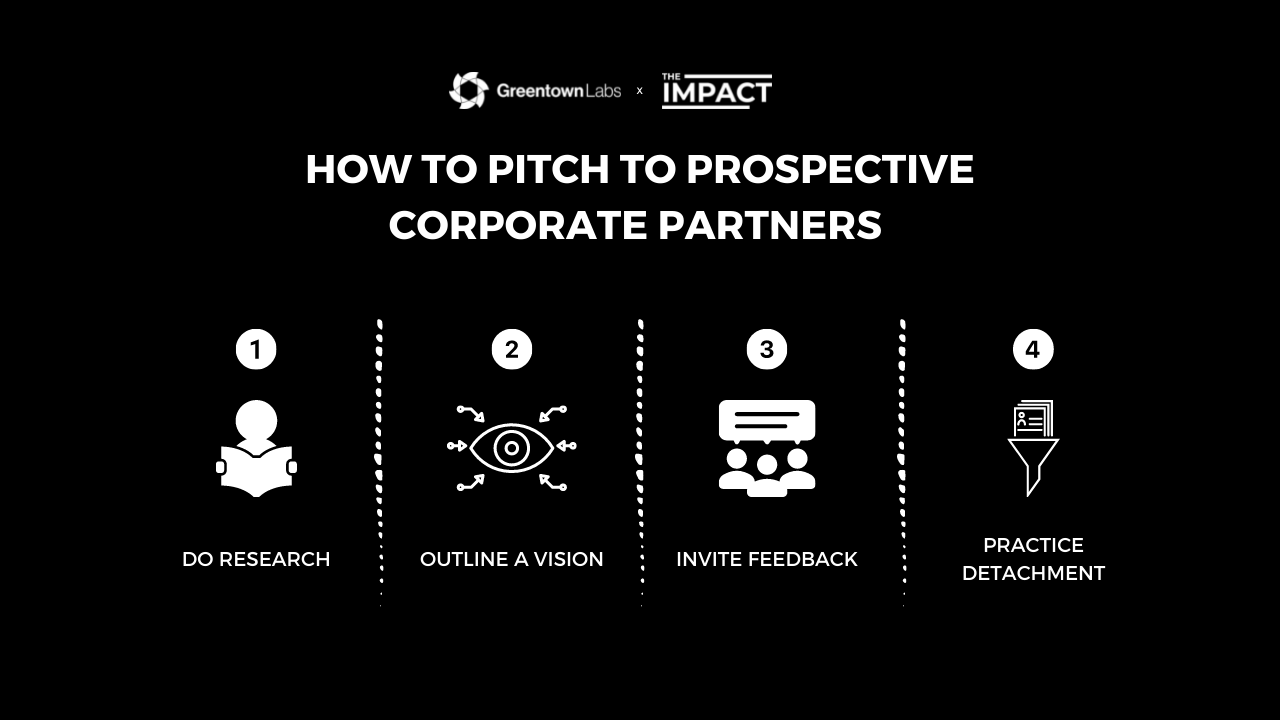Get the full series showing you how to navigate corporate partnerships as a climate tech startup. Subscribing also adds you to our free weekly newsletter.
For startups in general and climate tech startups in particular, corporations unlock key commercialization pathways. But pitching a prospective corporate partner is very different from pitching a venture capital firm. A venture capital firm generally has an established thesis and investment criteria and a carefully designed internal governance process. At a corporate, it’s rarely so straightforward.
First, as a rule, corporates closely guard information about their strategies in order to preserve their competitive advantage. This information asymmetry can present challenges for startups trying to understand their own potential relevance. Publicly available information may not present the whole story of how a startup and a corporate might productively work together.
Secondly, the decision-making unit at a corporate can be complex and expansive. Each team at a corporate is one part of a larger whole, with varying incentives and levels of information visibility. These dynamics often fluctuate in real-time, meaning consensus-building at a corporate can be much more art than science.
Specificity without Certainty
In this context, startups pitching to corporates should take an approach that may at first seem counterintuitive. Startups need to do their research to understand the corporate as best they can and outline a specific vision for their potential partnership that both advances the startup’s own objectives and aligns with the corporate’s strategy. But at the same time, the vision the startup presents must leave room for feedback and serendipity. This approach meets the challenges of both information asymmetry and the complex decision-making unit.
Four Steps for Pitching Partnership to Corporates
Startups preparing to pitch partnerships to corporates should follow four steps:
- Do research
- Outline a specific vision for partnership
- Invite feedback
- Practice detachment
Do Research
Information asymmetry notwithstanding, startups should seek to understand the prospective corporate partner as best they can. Why should this corporate partner, specifically, be excited about working with the startup? Identifying a corporate’s unique “wow” factor can be game-changing.
Startups can start by researching the corporate’s current business. For publicly traded companies, annual reports are a wealth of information about business lines and their relative importance within the corporate’s portfolio. Websites can be a more digestible source of similar information.
Just as important as understanding the corporate’s current business is understanding the corporate’s strategic outlook. This requires a bit more tea leaf reading. Startups can look at what the corporate has communicated on this topic: for example, its published innovation strategy and executive interviews. But startups should also seek out press releases and other coverage of past partnerships to read between the lines. What do the corporate’s actions indicate about its strategies or future ambitions that it might not be explicitly saying?
Outline a Specific Vision for Partnership
Having researched the corporate’s current business and its strategic outlook, the startup can then begin to outline a specific vision for partnership. This vision should advance the startup’s own objectives, and providing a high-level explanation of how it does so can build credibility with the corporate. The vision should also, of course, align to the startup’s understanding of the corporate’s strategic interests.
Specificity means speaking to the long-term value that the startup and the corporate can create together – in other words, what the commitment phase of the relationship might look like. It can also mean suggesting the intermediate milestones that might be needed to reach this outcome. Presenting suggested intermediate milestones is most helpful when the desired partnership outcome is less straightforward and/or the corporate stakeholders have less experience or comfort with startup collaborations.
Providing a specific vision for the corporate to react to is particularly helpful when dealing with a complex decision-making unit. Corporate stakeholders can either build upon the vision or suggest alternatives.
Invite Feedback
Even the most diligent startups will never be able to know everything about a corporate’s strategy. In this context, the way to cope with information asymmetry is to embrace it. Rather than feigning overconfidence, the startup should demonstrate that it is open to learning more about the corporate’s strategy and gaining the corporate’s feedback on potential partnership pathways.
Requesting feedback can be as simple as stating, “This is our view on how we could work together, but of course we’re eager to hear your feedback and any other ideas you might have.” Individual stakeholders from different internal corporate groups may provide differing suggestions, all of which can be valuable possibilities to explore.
Leaving the door open for feedback invites the corporate into dialogue with the startup and makes the pitch antifragile to information asymmetry. It also demonstrates humility and coachability: two important factors in any long-term relationship.
Practice Detachment
Pitching to corporates takes work, and because of information asymmetry and complex decision-making units, results may be determined by factors beyond the startup’s control or knowledge. Like many other aspects of a founder’s job, this can feel frustrating.
Startups that are able to practice attachment to effort rather than results will be best equipped to persevere. Rejection may feel personal, but the vast majority of the time, it is not. Startups should seek to control the controllables and be gentle with themselves as they learn over time.
Pursuing relationships with multiple corporates at the same time can help lessen the sting when individual partnerships do not materialize as hoped. And even an unsuccessful corporate pitch can be useful as a market validation or customer discovery exercise, provided that the startup is able to gather feedback from the corporate.
Onward
Corporate partnerships can be transformative for climate tech startups. But pitching a partnership to a corporate is very different than pitching to a VC firm. Because of information asymmetry and complex decision-making units, startups need a fresh approach.
Startups can meet this unique challenge by doing research, outlining a specific vision for partnership, inviting feedback, and practicing detachment. These four steps are more art than science, and startups should expect them to become easier over time. Most importantly, rejection should not be equated with failure.
Yes, pitching a partnership to a corporate takes work. At the same time, virtually nothing in the climate tech space is easy. That doesn’t mean it isn’t worth it.
About The Author

Katherine works at Greentown Labs leading partnership acceleration programs for climatetech startups and corporates. She has worked on topics from circular economy to carbon capture to offshore wind to hydrogen. Her pre-climatetech background is in commercial strategy and internal consulting.

